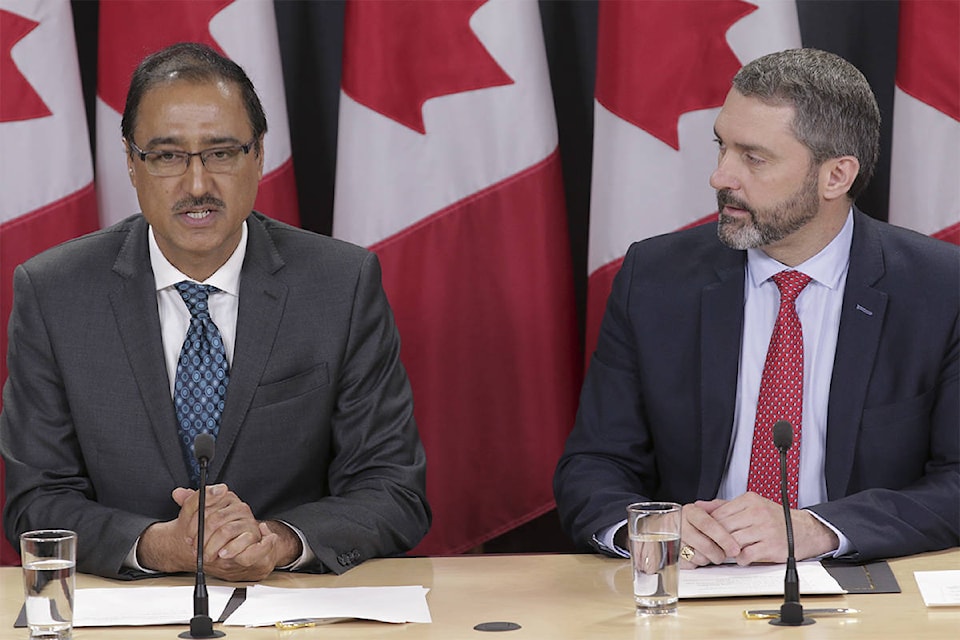The Canadian and Yukon governments have officially signed a bilateral agreement that will open up nearly $600 million in new funding for infrastructure projects in the territory over the next decade.
Federal Minister of Infrastructure and Communities, Amarjeet Sohi, Premier Sandy Silver and Yukon MP Larry Bagnell made the announcement at a press conference in Ottawa May 3.
Under the agreement, the Canadian government will be investing $445.6 million in projects covering four key areas — green infrastructure, community, cultural and recreational infrastructure, rural and northern communities infrastructure and public transit — over the next 10 years. The Yukon will chip in another $148.5 million, adding up to a total of more than $594 million.
The funding is part of the national Investing in Canada Plan that will see the federal government spend $180 billion over 12 years to address infrastructure priorities across the country. More than $33 billion of that is being disseminated via bilateral agreements with the provinces and territories, with the understanding that local governments will also be covering a portion of project costs.
Silver called the signing of the Yukon’s agreement a “landmark moment for our territory.”
“Now, the importance of this generous … federal contribution cannot be overstated,” he said. “It will enable the Government of Yukon and its partners, which include First Nations governments, municipalities and also the communities to strategically plan and invest in local infrastructure. The Investing in Canada Infrastructure Program will put Yukoners to work building the essential infrastructures needed to help ensure our communities are healthy, vibrant and sustainable.”
Among the infrastructure project goals, Silver said, are reducing greenhouse gas emissions, increasing energy efficiencies in buildings, modernizing water and wastewater systems, developing renewable energy resources, building or upgrading cultural venues and improving road and internet access.
“We all know that building infrastructure in the North is both challenging and expensive,” Silver said, “but that should not deter us from moving forward to delivering these legacy projects that will better this territory for many, many years to come.”
Silver did not give details on what those projects would be, saying that announcements with First Nations and municipal leaders would come later on.
Under the cost-sharing portion of Yukon’s bilateral agreement, the Canadian government will be covering up to 75 per cent of project costs. While the territorial government will cover the remaining 25 per cent in about two-thirds of the projects, it was revealed in April that it may ask First Nations governments and municipalities to fund the remaining costs for the other third. The proposal raised concerns from the Association of Yukon Communities and the Yukon Party that such a setup would mean that smaller, rural Yukon communities would be at a disadvantage compared to Whitehorse.
Silver said Thursday that conversations are still underway with municipalities and First Nations about how the funding split will work, and that the Yukon government “will make sure that every community has a voice.”
“It’s a matter of having the conversation, of making sure that none of this (federal) money stays on the table,” he said.
“I’m just very pleased to be able to sit down with municipalities and First Nations governments and have conversations about variables, about, how can we best make sure that this money gets spent.”
In his speech, Sohi said that the federal government “firmly believes that infrastructure is the foundation of building a stronger economy, building an economy that works for everyone, inclusive, welcoming communities as well as transition towards a low-carbon green economy.”
“These investments will help us to achieve a vision that we have for Canadian communities — communities that have cleaner air and water and are resilient to the impacts of changing climate, communities that have better access to cultural and public spaces that promote our diversity and bring us together, and the remote and northern communities that have better transportation, modern, digital infrastructure and improved energy security,” he said.
Bagnell called May 3 a “very exciting day for the Yukon.”
“When (the Yukon is) distanced (from Ottawa) like that, you can feel alienated,” he said, “but I can tell you after the huge announcement today, we don’t feel the least bit alienated.”
With files from Ashley Joannou
Contact Jackie Hong at jackie.hong@yukon-news.com
